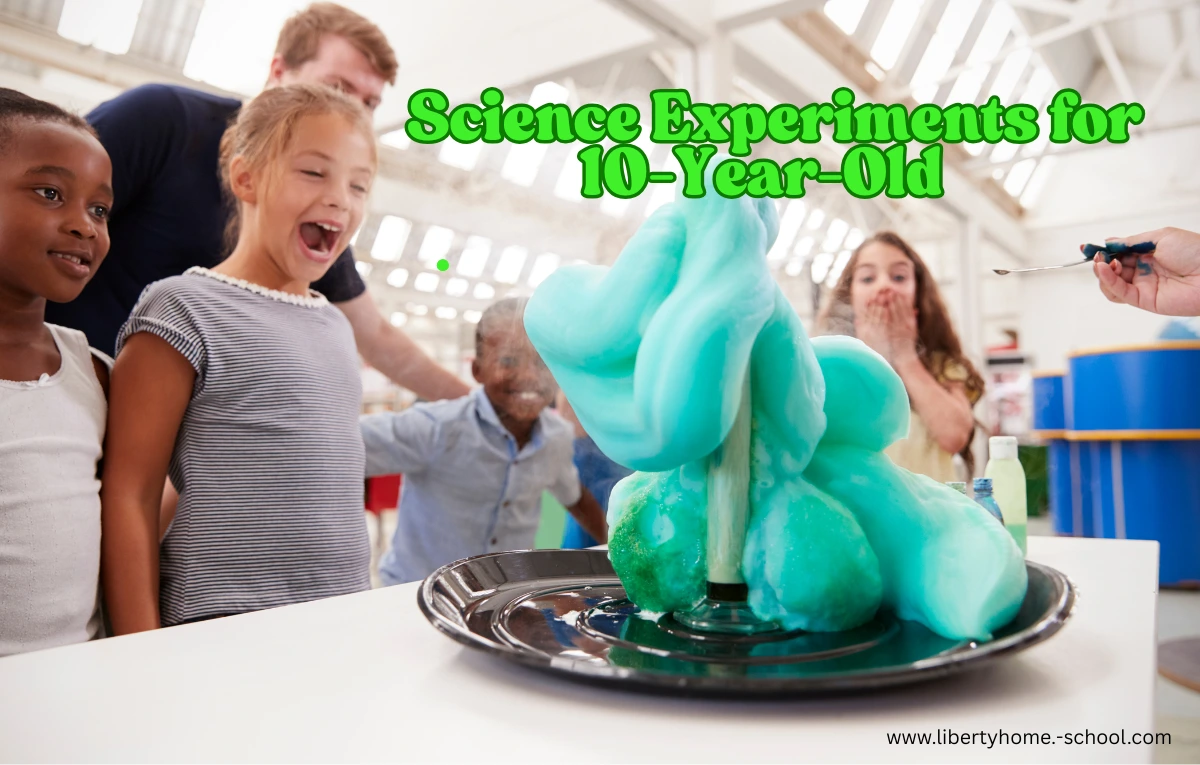Super Fun Science Experiments for 10-Year-Old Homeschoolers

Why Science Experiments Matter in Homeschooling
Let’s be honest—learning science from a textbook can be pretty dull. But the moment you hand your 10-year-old a bottle of vinegar and baking soda and say, “Check this out,” you can see their eyes light up. Suddenly, science feels real. It’s tangible. It’s fun!
If you’re homeschooling, you’re probably on the lookout for activities that are not only educational but also engaging and easy to set up. That’s where science experiments for 10-year-olds come into play. They’re hands-on, they help concepts stick, and they transform your kitchen table into a bustling science lab.
Are you ready to spark curiosity, creativity, and critical thinking? Let’s jump into 10 super fun, safe, and budget-friendly experiments that will have your 10-year-old asking for more “school.”
1. Invisible Ink Messages (Chemical Reaction & Acids)
What You’ll Need
- Lemon juice
- Cotton swab
- White paper
- Lamp or iron
🧠 What’s Happening:
Lemon juice is acidic, which means it weakens the paper where you apply it. When you add heat, the acid oxidizes more quickly than the rest of the paper, making your secret message pop up!

✅ Learning Outcome:
You’ll get to learn the basics of chemical reactions and oxidation while honing your skills as a stealthy spy.
💡 Tip:
Experiment with different fruits like orange or apple juice. Which one works the best? Be sure to jot down your findings!
2. DIY Volcano Eruption (Chemical Reactions)
What You’ll Need
- Baking soda
- Vinegar
- Dish soap
- Red food coloring
- Small container
🧠 What’s Happening:
This fun experiment showcases an acid-base reaction that releases carbon dioxide gas, creating a mini volcanic eruption right in your kitchen!

✅ Learning Outcome:
You’ll get to visualize some cool Earth science and chemistry concepts while making a delightful fizzy mess.
💡 Try This:
For an extra touch, craft a volcano using papier-mâché around the container to give it a more realistic appearance.
3. Magnetic Slime (Physics + Chemistry)
What You’ll Need
- Liquid starch
- White school glue
- Iron oxide powder
- Strong neodymium magnet
🧠 What’s Happening:
When you mix the glue and starch, they create a polymer (slime), and the iron oxide makes it responsive to magnetic fields—showing magnetism in action.

✅ Learning Outcome:
Dive into the fascinating world of forces and motion, and discover how magnetism interacts with matter.
⚠️ Safety Tip:
Make sure to wear gloves and keep a close eye when using iron oxide.
4. Growing Plants Without Soil (Botany)
What You’ll Need
- Cotton balls
- Glass jars
- Mung beans or lentils
- Water
🧠 What’s Happening:
This is a fun way to show how plants can grow in water and light—ideal for discussing photosynthesis and what plants really need to thrive.

✅ Learning Outcome:
Get a hands-on understanding of how plants grow and watch the germination process up close.
💡 Extension:
Try playing with light—put one jar in a dark spot and the other in sunlight. What do you notice?
5. Create a Lemon Battery (Electricity)
What You’ll Need:
- Lemons
- Zinc nails
- Copper pennies
- Alligator clips
- A small LED light
🧠 What’s Happening:
This fun and simple electrochemical reaction turns the acidity of the lemon into electricity, which can light up your LED.

✅ Learning Outcome:
You’ll learn the basics of building a circuit and get a grasp on how battery-powered energy works.
⚠️ Note:
If you’re using LED bulbs, just make sure they operate on low voltage.
6. Rainbow Water Density Tower (Physics + Chemistry)
What You’ll Need:
- Water
- Sugar
- Food coloring
- 5 clear cups
- Spoon
🧠 What’s Happening:
By adding more sugar to each cup, you’re actually changing the water’s density, which lets you create a beautiful rainbow layer effect.

✅ Learning Outcome:
You’ll get a clear understanding of density and solutions, all while enjoying a colorful display.
💡 Give This a Try:
Swap out the sugar for salt—does it create the same effect?
7. Tornado in a Bottle (Weather Science)
What You’ll Need:
- Two-liter bottle
- Water
- Glitter (optional)
- Dish soap
- Bottle connector or duct tape
🧠 What’s Happening:
Swirling the water simulates a vortex, showing how tornadoes form due to pressure differences in the atmosphere.
✅ Learning Outcome:
Link physical movement to meteorological concepts.
💡 Tip:
Compare it with actual tornado footage for real-world connections.
8. Bouncing Egg (Acid-Base Reaction)
What You’ll Need:
- A raw egg
- White vinegar
- A jar
🧠 What’s Happening:
The vinegar works its magic by dissolving the egg’s shell through an acid-base reaction, leaving behind a rubbery membrane. This is what gives you a “bouncing” egg!

✅ Learning Outcome:
You’ll get to observe osmosis in action and see how acids break down calcium carbonate.
⚠️ Safety:
Be sure to wear gloves when handling the egg—it’s quite delicate!
9. Homemade Lava Lamp (Density + Solubility)
What You’ll Need:
- Vegetable oil
- Water
- Food coloring
- Alka-Seltzer tablets
- Clear bottle
🧠 What’s Happening:
Oil and water don’t mix, but when you toss in those fizzing tablets, you create a mesmerizing lava lamp effect thanks to the changes in density and the release of gas.

✅ Learning Outcome:
Dive into the concepts of immiscibility, gas release, and density.
💡 Tip:
For an even cooler experience, turn off the lights and shine a flashlight on your creation!
10. Balloon Rocket (Newton’s Laws)
What You’ll Need:
- A balloon
- String
- Tape
- A straw
🧠 What’s Going On:
As the air escapes from the balloon, it pushes itself forward along the string—showing off Newton’s Third Law in action.

✅ Learning Outcome:
Explore concepts of motion, thrust, and the fundamentals of rocket science.
💡 Challenge:
Try out different balloon sizes. Which one can travel the farthest?
Why These Experiments Are Perfect for 10-Year-Olds ?
At the age of 10, kids are bursting with curiosity and eager to dive into understanding how the world ticks. These experiments spark problem-solving skills and encourage predictions, strengthen foundational subjects like chemistry, physics, and biology, utilize everyday household items, making them easy to access, align with NGSS science standards, and are just plain FUN—so kids won’t even notice they’re learning. Each activity opens up a gateway to a richer scientific concept, tailored to the unique learning pace of a homeschooled child.
Comparison Table: Quick Experiment Summary
| Experiment Name | Key Concept | Mess Level | Time | Parental Help |
|---|---|---|---|---|
| Invisible Ink | Chemical Reactions | Low | 15m | Minimal |
| Volcano Eruption | Acid-Base Reaction | Medium | 20m | Yes |
| Magnetic Slime | Magnetism & Chemistry | High | 25m | Yes |
| Grow Without Soil | Botany/Photosynthesis | Low | Multi-day | Minimal |
| Lemon Battery | Electricity | Medium | 30m | Yes |
| Rainbow Density Tower | Density & Solutions | Medium | 25m | Yes |
| Tornado in a Bottle | Weather Science | Low | 10m | No |
| Bouncing Egg | Acid-Base Reaction | Medium | 48 hrs | Yes |
| Homemade Lava Lamp | Solubility & Gas | Low | 15m | Yes |
| Balloon Rocket | Newton’s Laws | Low | 10m | No |
FAQ
- Are these experiments safe to do at home?
Absolutely! All the materials you’ll need are everyday items you probably already have. Just keep an eye on things when necessary. - Can younger siblings join in?
For sure! Just tweak the explanations and supervision to fit their age. - How do I connect these to a science curriculum?
Each activity aligns with core standards like NGSS and really boosts STEM learning. - Do I need to buy special tools?
Not at all—everything you need is likely already hanging out in your kitchen or craft supplies. - How often should I do experiments?
Once a week is perfect for keeping the learning fun and consistent without feeling overwhelming. - Can these work for a science fair?
Definitely! Just choose one, add a hypothesis and some variables, and you’re all set for the fair. - What if my child doesn’t enjoy science?
Start with the most visually exciting ones (like slime or the volcano) to spark their interest. - Is there a printable version of these experiments?
Yes! You can easily copy them and create a journal-friendly version for your homeschool binder. - Can I substitute any materials?
Many ingredients can be swapped out—feel free to get creative and see how the results change. - Where can I find more science ideas?
Check out homeschool blogs, YouTube science channels, or websites like NASA Kids and Mystery Science for more inspiration!

